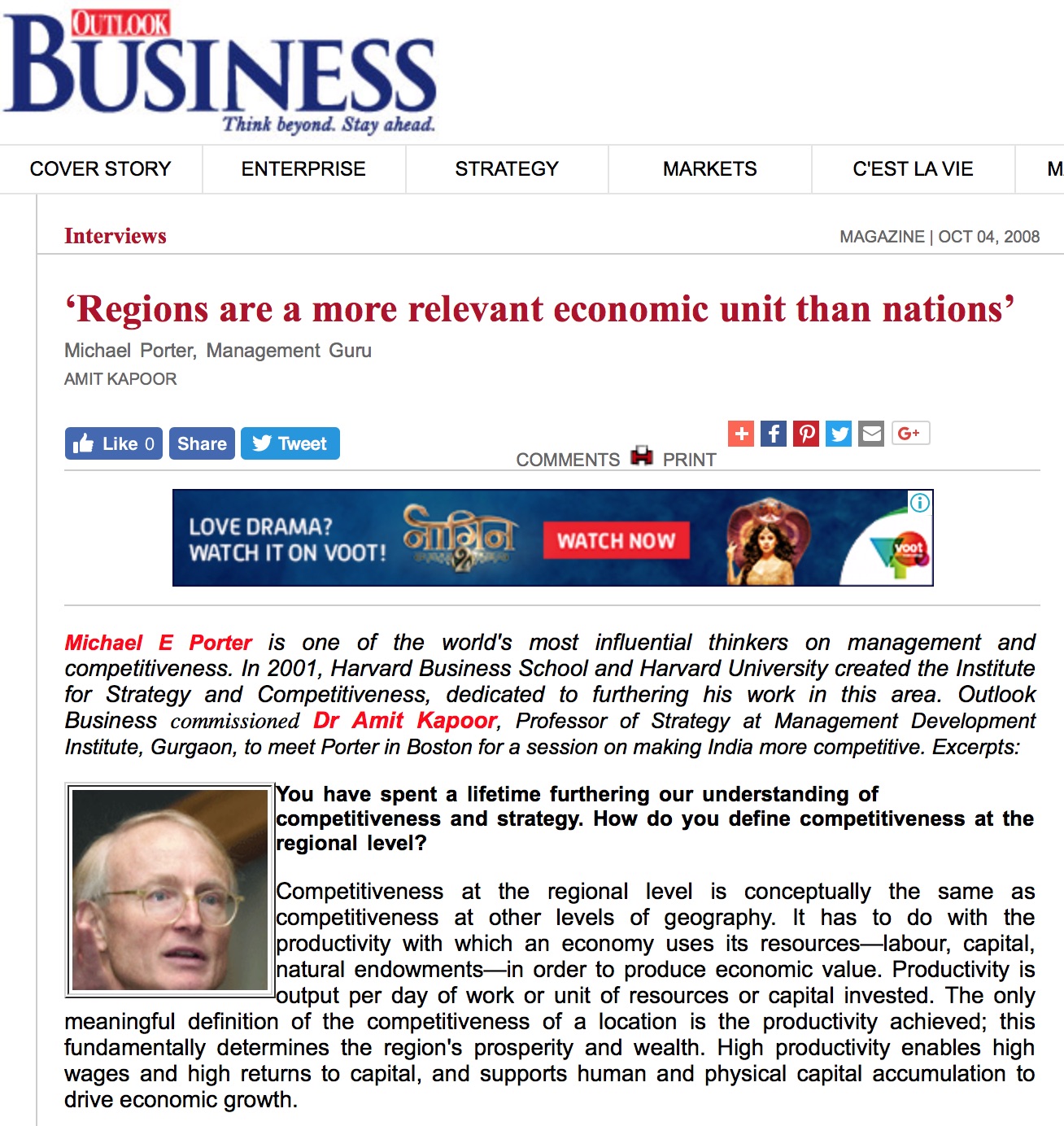A leader in global management education, Dipak C Jain is Dean of Insead and Dean Emeritus of the Kellogg School of Management at Northwestern University. In a conversation with Dr Amit Kapoor, Professor of Strategy and Industrial Economics at Management Development Institute, Gurgaon, Dr Jain offers his insights on the future of global business education.
Give me a brief picture of the global business education sector.
Growth in business school education accelerated in the 1970s. This demand increase stemmed from earlier shifts in the global economy in the aftermath of World War II, when business grew exponentially.
Today, there are close to 13,000 business schools globally. These schools, as an industry, are very fragmented and competitive. On the one hand, though schools in the West are not declining, market forces make it challenging for many of these institutions to enjoy significant breakthroughs with new customers. On the other, new market growth is occurring in countries where business itself is still growing, like India, China and Brazil.
These countries need teams of talented people to manage commercial growth. In fact, overseeing this growth is critical if companies want to avoid the fate of those who grow quickly beyond their capabilities and then suffer financial setbacks due to inadequate management.
What are the challenges that globalisation poses to this industry?
In terms of core offerings, a key challenge is to respond robustly to global realities by designing curricula that reflect the global management arena into which MBA students will enter. While Western schools try to create curricula that reflect a global business framework, their content is still very West-centric.
The Net presents interesting opportunities, but it does not offer a substitute for the face-to-face interaction in MBA programmes.
The way to counter the limitations of this approach is to accept the challenge of integrating global content into the curriculum, including material that is focused on emerging economies. I frame this objective along three dimensions that define the mission of business schools: global knowledge creation, global knowledge dissemination and global knowledge certification.
Given globalisation’s dynamics, our scholarship should not be limited by geography. There are many companies whose global strategy merits the attention of business scholars. Telenor, for instance, is a Norwegian company in Bangladesh operating on a large scale, including initiatives in Pakistan. They are also present in India, under the name Uninor and working in collaboration with Unitech. Studying a range of global players, to gain a comprehensive, accurate understanding of what “global business” means today is extremely important.
What models can global business schools adopt?
There are various models that schools can adopt to pursue this global vision. One way is to open your own campus with your own faculty, which amounts to a gigantic brick-and-mortar task. Another option is to establish your campus, but have faculty commute as needed to the site, teaching for a few days or weeks, and then return to their home campus. In this case, you are investing only in “hardware,” not “hardware and software,” as in the first instance.
A third model builds alliances with local institutions, which provide the hardware while you provide the faculty software. A fourth model is focused exclusively on non-degree executive education. An additional option is to “train the trainer”: You don’t deliver any programmes for the executives themselves, but just for their teachers.
The challenge for schools is to decide which of these models or which combination of models, is best for them.
How do you think the Internet is going to change B-school education?
Digital technology is playing an important role in how we communicate and learn. Recent events in West Asia show the impact of such media. For many people, the Internet offers a powerful channel to access content. But in terms of management education, I don’t think it will soon replace the traditional model of teaching that includes dynamic classroom interaction. The Internet presents interesting opportunities for enrichment but, at present, it does not offer a viable substitute for face-to-face collaboration that is central to the best MBA programmes.
Now, an online component could contribute to elucidating certain courses in MBA programmes, such as financial accounting, statistics or basic microeconomics. These can be taught online. Students can complete such study prior to starting their MBA studies on campus.
There are four pillars of a business school—research, teaching, training and consulting. Training occurs in-house while consulting is an external activity wherein you go to an enterprise and help them strategise. How do schools differentiate between training and consulting?
Quality research is fundamental to gaining significant external reputation. This is very important for business schools particularly if they can generate breakthrough research in India. Teaching moves us from knowledge creation to knowledge dissemination, and involves student satisfaction as well as the two-way discourse that can spark innovation inside and outside the classroom. Though teaching in India is well emphasised, since the research that supports it is limited, the teaching, too, can suffer.
In the US teaching and research are often linked, resulting in updated curricula that reflect the latest discoveries. Training and development are aspects of business schools’ short-term programmes. Not all students are interested in earning a degree. Some want to learn the straightforward fundamentals of business quickly. These people are important to us because they help build our reputation.
As for consulting, in the US this is done by the professors—but not at the institutional level. Consulting is an individual pursuit that builds one’s identity and the reputation of the academic institute.
The business model needs to be revised. The cost of attracting, developing and retaining faculty is higher than the cost of tuition.
Are business schools predominantly consulting entities? If not, how can that be accomplished?
Business schools can provide social value across many contexts, including in more defined, instrumental ways, similar to what consultancies offer. I would also say that the best schools are always seeking new ways to create academic innovation that transcends traditional notions of what management education is, and what management itself can accomplish.
Consultancies like McKinsey do a lot of business consulting, but they don’t have the power to certify the knowledge. On the other hand, business schools can certify their knowledge by granting a recognised degree. But business schools have the opportunity to institutionalise consulting as a strategy to increase revenue (knowledge monetisation). That said, my view of knowledge monetisation is slightly different. I think we should explore the entrepreneurial arena and design ways to provide entrepreneurs associated with our schools with the seed funding to support their ventures. The arrangement can benefit the individual as well as the institution, since a portion of the profits can be designated for the school. Thus, we become like an innovation incubator.
Can we look at a situation where business schools learn to monetise their research in a different way?
Without sacrificing core, disciplinary research, business schools can also pursue research for companies. Doing so successfully requires designing the appropriate incentives for faculty. My view is that the current business model needs to be revised. The cost of attracting, developing and retaining quality faculty is higher than the cost of tuition. This, however, does not imply that you simply increase tuition in ways that adversely impact students. We have to think of alternatives.
I believe in knowledge monetisation through entrepreneurial possibilities. For instance, schools can develop models to monetise student projects. Or they can design entrepreneurial frameworks with alumni that create win-wins for the individuals and the institutions.
If faculty is going to spend less time on teaching, then is it not an act of individual rationality turning into collective irrationality?
The question is, who will do the teaching as it is mandatory to teach the course in the school. This is a significant challenge at many business schools globally. My view is that complementary intellectual resources can come to bear on the entire academic enterprise—both in teaching and in research.
One solution to ensure quality teaching is to enlist excellent practitioners as adjunct faculty. These people may not have a doctoral degree or much formal research background, but they are people with vast experience and interest in disseminating knowledge. Such teachers would be in great demand, since they bring another kind of knowledge that many students desire.
One consideration to remember is that the degree programmes at most business schools are not true profit centres. So you need to think about how to grow the top line by exploring all the ways at your disposal to allocate your resources for maximum effect.
What is your take on the role of tenure? Will it prove to be an effective tool in Indian universities?
The tenure system ensures that faculty, as they advance in their careers, can focus on big research and big problems rather than concern themselves with frequent publication [of research papers]. Research is a field that has never been incentivised. In the Indian education system, promotions are based on work experience and rank, not merit. This matter requires
serious and detailed reflection.
Schools should explicitly recognise and compensate the best researchers by placing them in more prominent positions. One can gain more responsibilities within the school, which can then add to one’s market value. In India, though, this prospect faces serious challenges. Here, the research is diminishing because there is neither an explicit recognition nor reward system.
If you continue doing research, you can grow from a lecturer to a reader and then to a professor. In the US, one earns promotion through publication, teaching performance and service to the institute. But in India, this US-style tenure system is not prevalent.
The most interesting fact about faculty is that they are fiercely independent, academic entrepreneurs working in isolation. How do you manage that streak and motivate them?
First, one must understand that influence, rather than head-to-head power games, offers the best way to engage your faculty in most cases. These are people with
authority and experience, and they cannot be dictated to.
The second important factor is to cultivate a sense of inclusiveness within the school. Third, faculty should be entrusted with governance roles within the school, because they are the soul of the institution.
But to address an assumption about faculty in your question, I would also suggest that schools can, by implementing appropriate incentives, encourage faculty to work together more to generate valuable knowledge. Schools should be willing to consider how to accommodate various ways of achieving academic excellence.
Could you share with us the definition of leadership and strategy?
In academic administration, leadership involves setting the school’s strategic direction and refining its ability to anticipate challenges and opportunities. You anticipate global positioning and the trends in the market before your competitors do and thus become the best marketing school. The premier aspect of leadership is to delegate responsibilities to people who are willing and able to take them up with passion and expertise.
For strategy, I have a simple rule: When you take an action, you should know the possible implications and have these incorporated into your plan before making the move. It is especially important to think these things through and marshal all necessary resources to help you manage effectively during times of crisis.
Given the complexity of the global marketplace and the growth in emerging economies, management education is going to be even more important in the years ahead.
The 4 global business school models
- Own Campus, Own faculty
- Own Campus, Fly-in and fly-out faculty
- Local Institution, Foreign Faculty (alliance model)
- Exclusive Executive Education (non-degree education)
The 4 pillars of a successful business school
Knowledge Creation
- Research part, important for turning global.
Knowledge dissemination
- Disseminating knowledge by creating alliances and setting up campuses in different nations.
Knowledge certification
- Granting degrees, authority of management schools.
Knowledge monetisation
- Monetisation of both research and students’ projects. A tool of increasing productivity by acting as an incentive.
4Cs Model
Context
- West and region-centric education.
- Obsolete business model.
- Lack of befitting incentives for faculty.
Customer
- National and international students.
- Demanding value for brand.
- Unwilling to pay huge tuition fee.
Company
- Belief in the growth of management; opted for knowledge creation and knowledge dissemination programmes over knowledge certification ones.
- Adoption of a global content course.
Competition
- Competition coming from emerging economies experiencing growth and demanding talent. Modus operandi is to work in collaboration with other schools (both national and international).
- The top seven B-schools in the US and other Asian and international business schools.
Industry metamorphosis
The Strat Speak interaction was published with Outlook Business on August 6, 2011.
























